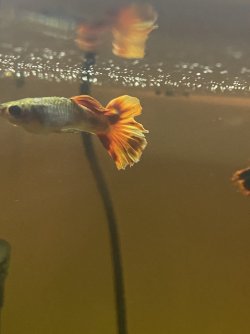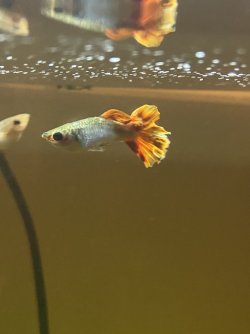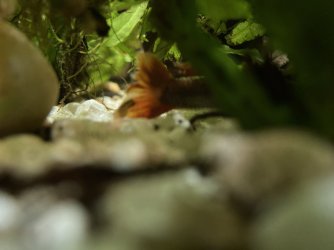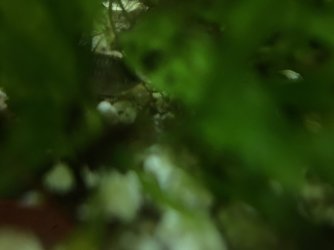-
Guest, the Tank of the Year contest is underway!
💧 Which tank will win? 👉 View the entries and vote now!!
You are using an out of date browser. It may not display this or other websites correctly.
You should upgrade or use an alternative browser.
You should upgrade or use an alternative browser.
My Guppy Needs Help!
- Thread starter Jownsa
- Start date
When you say a lump on the tail, is it on the bottom half of the tail (red or black mark) or where the tail joins the body?
Is the fish eating well?
What does its poop look like?
If the fish is eating well and does a normal coloured poop (not white), then the scales lifting on the back are probably from an external protozoan infection. You can try adding salt and see if it helps.
You should check the water quality for ammonia, nitrite, nitrate and pH.
Do a 75% water change and gravel clean the substrate before adding salt.
Make sure any new water is free of chlorine/ chloramine before it's added to the tank.
Clean the filter if it hasn't been done in the last 2 weeks. Wash filter media/ materials in a bucket of tank water and re-use the media. Tip the bucket of dirty water on the lawn outside.
If there's no improvement a few days after cleaning the tank, gravel and filter, and adding salt, then post more pictures and a 1 minute video of the fish. Upload videos to YouTube, then coy & paste the link here.
---------------------
SALT
You can add rock salt (often sold as aquarium salt), swimming pool salt, or any non iodised salt (sodium chloride) to the aquarium at the dose rate of 1 heaped tablespoon per 20 litres (5 gallons) of water. If there is no improvement after 48 hours you can double that dose rate so there is 2 heaped tablespoons of salt per 20 litres.
Keep the salt level like this for 1-2 weeks.
The salt will not affect the beneficial filter bacteria, fish, plants, shrimp or snails.
After you use salt and the fish have recovered, you do a 10% water change each day for a week using only fresh water that has been dechlorinated. Then do a 20% water change each day for a week. Then you can do bigger water changes after that. This dilutes the salt out of the tank slowly so it doesn't harm the fish.
If you do water changes while using salt, you need to treat the new water with salt before adding it to the tank. This will keep the salt level stable in the tank and minimise stress on the fish.
When you first add salt, add the salt to a small bucket of tank water and dissolve the salt. Then slowly pour the salt water into the tank near the filter outlet. Add the salt over a couple of minutes.
Is the fish eating well?
What does its poop look like?
If the fish is eating well and does a normal coloured poop (not white), then the scales lifting on the back are probably from an external protozoan infection. You can try adding salt and see if it helps.
You should check the water quality for ammonia, nitrite, nitrate and pH.
Do a 75% water change and gravel clean the substrate before adding salt.
Make sure any new water is free of chlorine/ chloramine before it's added to the tank.
Clean the filter if it hasn't been done in the last 2 weeks. Wash filter media/ materials in a bucket of tank water and re-use the media. Tip the bucket of dirty water on the lawn outside.
If there's no improvement a few days after cleaning the tank, gravel and filter, and adding salt, then post more pictures and a 1 minute video of the fish. Upload videos to YouTube, then coy & paste the link here.
---------------------
SALT
You can add rock salt (often sold as aquarium salt), swimming pool salt, or any non iodised salt (sodium chloride) to the aquarium at the dose rate of 1 heaped tablespoon per 20 litres (5 gallons) of water. If there is no improvement after 48 hours you can double that dose rate so there is 2 heaped tablespoons of salt per 20 litres.
Keep the salt level like this for 1-2 weeks.
The salt will not affect the beneficial filter bacteria, fish, plants, shrimp or snails.
After you use salt and the fish have recovered, you do a 10% water change each day for a week using only fresh water that has been dechlorinated. Then do a 20% water change each day for a week. Then you can do bigger water changes after that. This dilutes the salt out of the tank slowly so it doesn't harm the fish.
If you do water changes while using salt, you need to treat the new water with salt before adding it to the tank. This will keep the salt level stable in the tank and minimise stress on the fish.
When you first add salt, add the salt to a small bucket of tank water and dissolve the salt. Then slowly pour the salt water into the tank near the filter outlet. Add the salt over a couple of minutes.
Thank you very much for your response, but he also appears to have dropsy.When you say a lump on the tail, is it on the bottom half of the tail (red or black mark) or where the tail joins the body?
Is the fish eating well?
What does its poop look like?
If the fish is eating well and does a normal coloured poop (not white), then the scales lifting on the back are probably from an external protozoan infection. You can try adding salt and see if it helps.
You should check the water quality for ammonia, nitrite, nitrate and pH.
Do a 75% water change and gravel clean the substrate before adding salt.
Make sure any new water is free of chlorine/ chloramine before it's added to the tank.
Clean the filter if it hasn't been done in the last 2 weeks. Wash filter media/ materials in a bucket of tank water and re-use the media. Tip the bucket of dirty water on the lawn outside.
If there's no improvement a few days after cleaning the tank, gravel and filter, and adding salt, then post more pictures and a 1 minute video of the fish. Upload videos to YouTube, then coy & paste the link here.
---------------------
SALT
You can add rock salt (often sold as aquarium salt), swimming pool salt, or any non iodised salt (sodium chloride) to the aquarium at the dose rate of 1 heaped tablespoon per 20 litres (5 gallons) of water. If there is no improvement after 48 hours you can double that dose rate so there is 2 heaped tablespoons of salt per 20 litres.
Keep the salt level like this for 1-2 weeks.
The salt will not affect the beneficial filter bacteria, fish, plants, shrimp or snails.
After you use salt and the fish have recovered, you do a 10% water change each day for a week using only fresh water that has been dechlorinated. Then do a 20% water change each day for a week. Then you can do bigger water changes after that. This dilutes the salt out of the tank slowly so it doesn't harm the fish.
If you do water changes while using salt, you need to treat the new water with salt before adding it to the tank. This will keep the salt level stable in the tank and minimise stress on the fish.
When you first add salt, add the salt to a small bucket of tank water and dissolve the salt. Then slowly pour the salt water into the tank near the filter outlet. Add the salt over a couple of minutes.
Is the fish eating?
What does his poop look like?
Dropsy will cause fish to bloat up (get fat) overnight, stop eating and usually do a stringy white poop. The fish's scales on the side of the body will stick out due to the sudden bloating. Fish with dropsy usually die within 24-48 hours of showing symptoms.
The fish in the picture has scales that are raised on the back. This is not normally dropsy but can be an external bacterial or protozoan infection. Salt can sometimes treat these.
What does his poop look like?
Dropsy will cause fish to bloat up (get fat) overnight, stop eating and usually do a stringy white poop. The fish's scales on the side of the body will stick out due to the sudden bloating. Fish with dropsy usually die within 24-48 hours of showing symptoms.
The fish in the picture has scales that are raised on the back. This is not normally dropsy but can be an external bacterial or protozoan infection. Salt can sometimes treat these.
CaptainBarnicles
Moderate Pleco Tolerator
Staff member
Global Moderator ⚒️
Tank of the Month 🏆
Pet of the Month 🎖️

Dropsy makes a fish look like a pinecone with all its scales standing out away from its body
Looking at his rear part of the body now he's on the bottom, does look like dropsy. It looks as if his scales are open. I don't know what I'm looking at in the second photo. If he stays on the bottom, than the dropsy has gone too far already and basically not curable anymore.Update:
Similar threads
- Replies
- 4
- Views
- 272
- Replies
- 3
- Views
- 217
- Replies
- 38
- Views
- 2K
Most reactions
-
 355
355 -
 160
160 -
 144
144 -
 143
143 -
 139
139 -
 119
119 -
 110
110 -
 100
100 -
 97
97 -
 75
75 -
 71
71 -
 64
64 -
 55
55 -
 54
54 -
F
49




